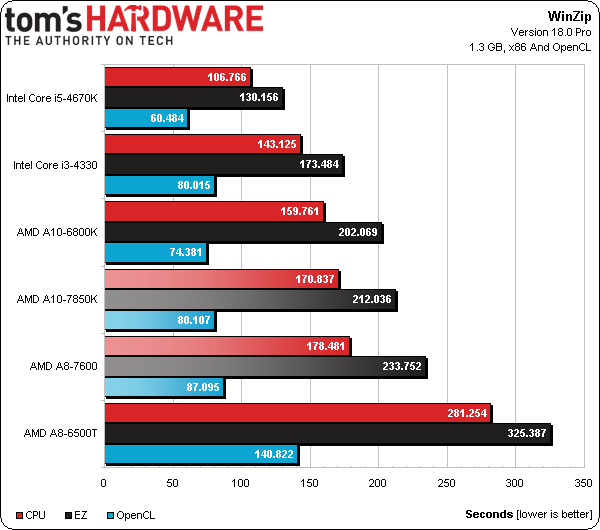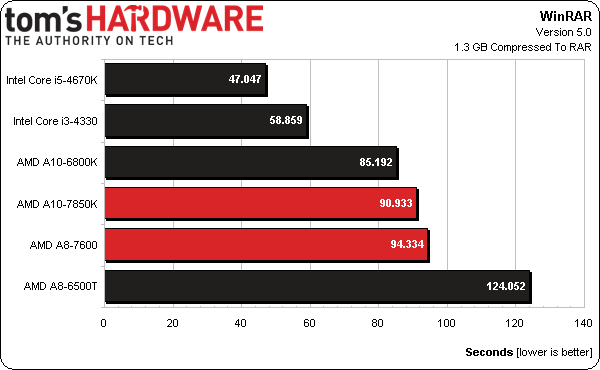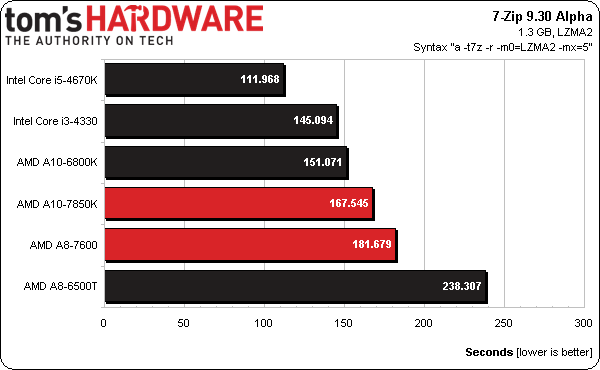AMD A10-7850K And A8-7600: Kaveri Gives Us A Taste Of HSA
We've spent the days following CES benchmarking two of AMD's new Kaveri-based APUs. Do the Steamroller x86 architecture, GCN graphics design, and HSA-oriented features impress, or do they come up short against Intel's value-oriented Haswell-based parts?
Results: Compression Apps
Our WinZip 18 benchmark has three components: a pure CPU test, a maximum compression (EZ) run, and an OpenCL-accelerated pass.
The fact that A10-6800K finishes the CPU-specific metric (in red) ahead of -7850K suggests that we aren’t getting maximum utilization. In any case, the Core i3 is both cheaper and faster than AMD’s fastest Kaveri-based APU.
Creating a more intense load with the EZ setting doesn’t change the finishing order—it only makes each run take longer.
Switching on OpenCL does help, though. In this case, the A10-6800K jumps in ahead of Intel’s Core i3. The A10-7850K roughly ties the Intel CPU (albeit at a $30+-higher price point). It also bears mention that the Core i3 is a 54 W part, while AMD is hitting 95 and 65 W thermal ceilings with the two Kaveri APUs in our chart.
The latest version of WinRAR is fairly effective at utilizing parallel computing resources; however, the Kaveri APUs trail a bit behind Richland. The Haswell-based Intel processors are significantly faster.
Shifting down to 45 W on the A8-7600 yields a completion time of 111 seconds. As enthusiasts, it’s most natural for us to look at the highest-end parts for inspiration. But in the case of Kaveri, AMD says it focused its attention in the 35 to 45 W band. It shows, too.
7-Zip is typically considered one of the best-threaded compression workloads in our benchmark suite, so it’s a bummer to see Kaveri receiving little validation at the 95 W level. Fortunately, the 65 W A8-7600 gives up fairly little performance for a big reduction in peak thermal dissipation. It’ll be interesting to see how this translates over to our efficiency calculations across the entire benchmark suite.
Get Tom's Hardware's best news and in-depth reviews, straight to your inbox.
Current page: Results: Compression Apps
Prev Page Results: Productivity Next Page Results: Media Encoding-
Someone Somewhere Yeah, almost all the diagrams refer to the 4760K.Reply
Given that AM3+ looks like it's done, it would have been nice to see a 6-core chip. Still, one of these may end up in my next laptop. -
spp85 A10-7850k is slower than A10-6800K ?? WTF. Its all hype than actual performance to the table. Even on OpenCL GPU accelerated apps doesn't have any advantage with A10-7850k over i5 or sometimes i3 CPUs. Hopeless is what I feel about AMD CPUs.Reply -
Someone Somewhere Reply12454254 said:A10-7850k is slower than A10-6800K ?? WTF.
I got the opposite impression. Which graph are you looking at? -
Jaroslav Jandek Thank you for the article (especially the power consumption measurements), Chris. It is definitely an improvement over Richland but kind of boring (disappointingly expectable).Reply
I really like where AMD is going (HSA, GCN and TrueAudio).Too bad the manufacturing process of GlobalFoundries just can't match Intel's.
Also, it would be interesting to see the new Bay Trail Pentium or Celeron CPUs (whichever is closer in performance) in the Efficiency graphs. -
Someone Somewhere I'm fairly sure that this is on TSMC's 28nm node. GlobalFoundries can't do that yet; this is on the same process used for AMD GPUs currently.Reply -
Jaroslav Jandek Reply
28nm SHP from GlobalFoundries. AMD bought over $1 billion worth of wafers from them in december...12454280 said:I'm fairly sure that this is on TSMC's 28nm node. GlobalFoundries can't do that yet; this is on the same process used for AMD GPUs currently.
I guess you have been reading the articles from a year ago about AMD still using TSMC despite promises of GlobalFoundries' new 28nm SHP process. -
jacobian I don't really believe into the whole HSA smoke-screen. By the time HSA-enabled apps take off, you will be ready to upgrade from your CPU again. The one terrible truth that stands out right now is that at current prices, the flagship Kaveri A10 doesn't make any sense whatsoever. Kaveri A8? Maybe. Richland A10-6790K? Perhaps. But the Kaveri A10 at $180 is a just a joke, specially after all that hype.Reply -
Someone Somewhere CPUs are usually released at ridiculous prices, and come down over a month or two.Reply



